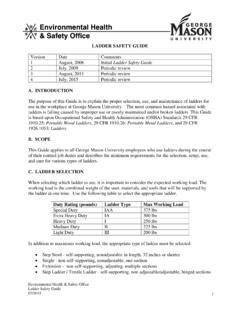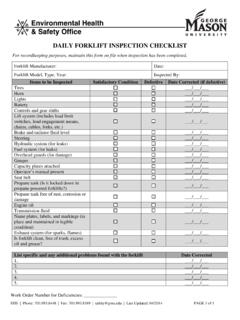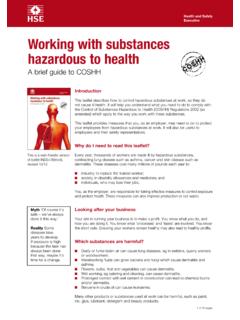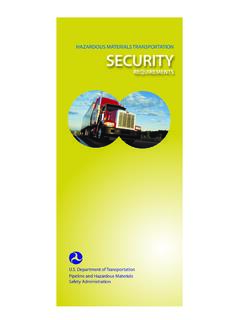Transcription of HAZARDOUS MATERIALS SHIPPING & RECEIVING GUIDE
1 HAZARDOUS MATERIALS SHIPPING & RECEIVING GUIDE Version Date Comments 1 September, 2013 Initial HAZARDOUS MATERIALS SHIPPING and RECEIVING GUIDE A. INTRODUCTION This HAZARDOUS MATERIALS SHIPPING and RECEIVING GUIDE outlines the requirements necessary for the proper acceptance procedures for receipt of all shipments of HAZARDOUS MATERIALS and for shipment of HAZARDOUS MATERIALS by university employees. Following this GUIDE will facilitate safe and secure receipt of packages as well as proper, safe, an expedient shipment of HAZARDOUS MATERIALS in accordance with US Department of Transportation (DOT) regulations outlined in 49 CFR172. B. SCOPE This GUIDE applies to all university employees who receive or sign for packages containing HAZARDOUS MATERIALS and any personnel who may be required to ship HAZARDOUS MATERIALS on an infrequent basis.
2 C. HAZARDOUS MATERIALS A HAZARDOUS material is defined as a substance or material that is capable of posing an unreasonable risk to health, safety, and property when transported in commerce. The term includes HAZARDOUS substances, HAZARDOUS wastes, marine pollutants, and elevated temperature MATERIALS . The Environmental Health and Safety Office (EHS) will assist in identifying what MATERIALS are and are not HAZARDOUS MATERIALS upon request. There are nine hazard classes: Hazard class Name of class or division Examples of MATERIALS Class 1 Explosives Picric acid, nitroglycerin, ammunition Class Flammable gas Hydrogen, acetylene, butane Class Non-flammable gas Nitrogen, helium, argon Class 3 Flammable liquid Alcohols, Ethers, acetone, acrylonitrile Class Flammable solid Paraformaldehyde, aluminum powder Class Spontaneously combustible Sodium hydrosulfite, potassium sulfide Class Dangerous when wet Sodium borohydride, sodium metal Class Oxidizer Potassium permanganate, sodium nitrate Class Organic peroxide Benzoyl peroxide Class Toxic substance Azides, cyanides, mercury compounds Class Infectious substance HIV cultures, human MATERIALS Class 7 Radioactive material 35S, 14C , 3H.
3 32P Class 8 Corrosive Hydrochloric acid, sulfuric acid Class 9 Miscellaneous dangerous goods Dry ice, lithium batteries, PCB s Environmental Health & Safety Office HAZARDOUS MATERIALS SHIPPING and RECEIVING GUIDE 09/2013 1 D. IDENTIFYING A HAZARDOUS MATERIALS PACKAGE DOT-approved packaging is the primary indication that a shipment contains HAZARDOUS MATERIALS (See Attachment A: Indications of a HAZARDOUS MATERIALS Package for examples): Packages marked or labeled with a UN or NA notation followed by a 4 digit number and the proper name and quantity of the HAZARDOUS material being shipped. The present of a square on point or diamond shaped label(s) or markings containing an associated hazard class number also indicate that the package contains HAZARDOUS MATERIALS .
4 Packages of exempt or limited quantities may be marked Limited Quantity , or DOT-E followed by a four digit number. Or the package may have a square on point label or marking with the top and bottom portions in black with a white center or a suitable contrasting color to the background. A black letter Y may be present in the white center indicating a limited quantity shipped by air. HAZARDOUS material is commonly shipped with a HAZARDOUS material SHIPPING paper, dangerous goods declaration, or bill of lading, which will directly identify the proper name, class, and amount of HAZARDOUS material being shipped. See Attachment A for example. Some HAZARDOUS MATERIALS are sent in exempt or limited quantities and will not be accompanied by, or identified on, a SHIPPING paper.
5 E. RECEIVING HAZARDOUS MATERIALS When RECEIVING HAZARDOUS MATERIALS always follow these steps before signing for them: Verify that you are approved to accept the package. o If you did not place the order, or were not given prior authorization to accept it by a supervisor, do not accept or sign for the package. Examine the exterior of all packages. o If any physical damage is noted; rips, tears, leaking, staining or discoloration do not accept the package. o If the package is producing a strong odor contact EHS at (703) 993-8448 for further guidance . o If the contents sound loose or broken while handling do not accept the package. Review the SHIPPING papers to ensure the items described are present. o If the items do not match the description do not accept the package.
6 If any discrepancies or damages are observed and the shipper refuses to return the package, has left the premises, or is otherwise unavailable, contact EHS immediately and EHS personnel will handle the package in accordance with transportation and safety regulations. Once the package has been examined and accepted, immediately secure the package in proper storage to prevent theft, loss, or damage. Do not leave the package unsecured. Environmental Health & Safety Office HAZARDOUS MATERIALS SHIPPING and RECEIVING GUIDE 09/2013 2 Do not handle any contents of a HAZARDOUS MATERIALS package unless you have been properly trained in the hazards that may be present and how to protect your health and safety. If you discover a damaged, leaking or open container of HAZARDOUS material after RECEIVING a package immediately contact campus police and inform them of your location and situation.
7 Secure the package in a safe location, if you have access to a fume hood place the package inside and close the sash, and do not attempt any other actions until EHS has made an evaluation of the situation. F. SHIPPING HAZARDOUS MATERIALS Both the International Air Transport Association (IATA) and DOT regulate the SHIPPING of HAZARDOUS MATERIALS and/or dangerous goods transported via road or air, respectively. This includes the transport of all chemicals with the exception of sample amounts ( ) between university campuses. Specific training is required and necessary to prepare and package a shipment of HAZARDOUS material . Employees who may be required to ship such items infrequently must contact EHS who will then provide this service.
8 In order for a shipment to be prepared and expedited properly the individual seeking shipment must notify EHS at least five business days for chemical shipments and at least two days for biological MATERIALS (including dry ice) in advance of the desired SHIPPING date and provide: Itemized list of contents of the package to include volume, weight, and size of the container(s). An appropriate SHIPPING container that meets UN packaging requirements (can be purchased through EHS if the department does not have the appropriate containers and the shipment is urgent) Dry ice and quantity to be included in the package (if required). Package (length, width, height, and weight). Insurance for the package (if any). Payment information; org and account number or third party FedEx account number to charge the shipment.
9 Shipper s name and a 24-hour phone number Consignee s (receiver s) name, address, and phone number. Individuals who ship HAZARDOUS MATERIALS on a frequent or routine basis must contact EHS to coordinate training for them to perform this task. Under no conditions are students permitted to offer HAZARDOUS MATERIALS for shipment on behalf of the university. Environmental Health & Safety Office HAZARDOUS MATERIALS SHIPPING and RECEIVING GUIDE 09/2013 3 Attachment A: Indications of a HAZARDOUS MATERIALS Package Figure 1. Square on point DOT Hazard classification labels Figure 2. DOT specification packaging with square on point label Environmental Health & Safety Office HAZARDOUS MATERIALS SHIPPING and RECEIVING GUIDE 09/2013 4 Figure 3.
10 HAZARDOUS MATERIALS /Dangerous Goods declaration note red and white border Figure 4. Limited quantity labels Y designation is for air shipments Figure 5. DOT E, exempt quantity label, will also contain 4 digit number and material name Environmental Health & Safety Office HAZARDOUS MATERIALS SHIPPING and RECEIVING GUIDE 09/2013 5








